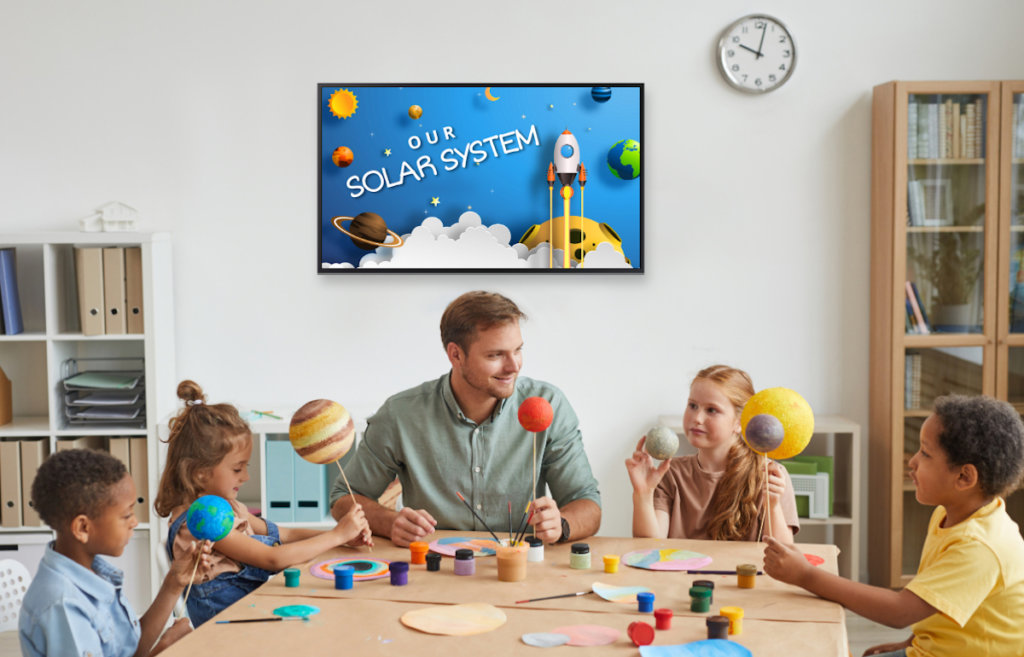
Printed signs are out-date, labor-intensive, and disconnected, so why do so many schools still use them? Now that kindergarten to university students are all digital natives, it’s time schools invested in more modern communication systems.
Digital signage is a cost-effective alternative that streamlines communication in schools. From sharing morning announcements to helping students find their ways between classes, educational institutions can use digital signage for any of the six following benefits.

1. Enhance Educational Outcomes in Classroom Settings
Many schools still use whiteboards and markers, but experts advocate for a more significant educational technology presence in classrooms. Screens were once thought of as a distraction, but computers, tablets, and digital signs may encourage students to participate in class activities.
Teachers can use digital signs in their classrooms to make learning fun and interactive. Digital signage software is customizable, so teachers can display pictures, text, graphs, maps, games, and other eye-popping presentations that incentivize students to pay attention and participate. Accounting for different learning styles is less complicated when educators are able to incorporate multiple kinds of media into their lessons.
Another benefit of digital signage in schools is recognizing students. Schools that acknowledge pupils’ accomplishments, such as receiving awards and scholarships, validate their students’ work and boost morale. In the case of younger grades, teachers can celebrate children’s birthdays and appreciate them for completing classroom chores.
2. Make Wayfinding Easier Across Campus
No matter how your campus is laid out, digital signs make navigation a lot easier. Universities, especially, benefit from customizable signs that can inform students and faculty where classrooms and departments are located across large campuses. School administrators can even set up TV screens in hallways to direct passersby toward offices and meeting rooms that have relocated.
Students and faculty eventually learn their ways around campus and don’t need directions for forever. However, they are not the only people who need to navigate schools. Parents, guest lecturers, and other visitors will be glad to have visually distinct digital signs that don’t fade into the background.
3. Communicate Updates and Announcements
School administrators regularly need to communicate with hundreds or even thousands of students and staff members, but email and traditional school signage convey information inefficiently. Digital signs set up in common areas and hallways, however, are excellent for mass communication.
Students sitting in the library can find out about upcoming events just by looking up at TV screens positioned on nearby walls, and teachers can learn about essential updates while making coffee in department offices. Digital signage allows schools to share critical information in real-time so that students and staff know precisely what they need to, when they need to.
Examples of other announcements schools can use digital signage for include:
- Fundraising events
- Sporting event results
- Building and traffic construction
- Test dates
- Extracurricular activity schedules
- Student accomplishments and recognition
- Lunch menus
And much more.
4. Make Faculty Meetings More Engaging
65% of people are visual learners. Not only can visual aids improve learning in classrooms, but they can also make staff meetings more engaging and participatory. Department heads can create such aids with digital signage to discuss curriculum changes, student attendance, upcoming events, and financial matters.
Small screens with digital signage software installed outside meeting rooms are useful for ensuring guests are in the right place and marking when rooms are booked. They can also streamline the booking process itself by reducing the potential for scheduling conflicts.
5. Bring in Additional Funds With Advertising Opportunities
Many schools take advantage of advertising to raise funds that make important extra-curricular activities like after-school programs, student clubs and sports leagues possible. While advertisers have plenty of interest in marketing for schools, it can be difficult for administrators where they can accommodate advertising. Digital signs positioned in public places offer an easy way to for advertisers to reach students.
Signs that announce sales, events, and news can display sponsor’s logos and information. For example, say a football game is coming up. Community sponsors who will be present at the game to sell their merchandise can rent a screen to talk about their products, brand, and prices to get students excited. Schools that use signage in this way can generate additional revenue streams.
6. Improve Safety Protocols & Reduce Accidents
Every educational institution needs a comprehensive safety plan that helps people evacuate buildings as quickly and seamlessly as possible. Schools traditionally post evacuation plans on walls or paper bulletin boards, but students and staff may not have taken the time to memorize these plans and, therefore, put themselves in danger when emergencies arise.
Digital signage for schools can integrate with alarm systems to notify building occupants about emergencies and direct them where to go. If the emergency requires people to stay inside, such as extreme weather, then digital signs can change to communicate lockdown protocols. Implementing a system that informs students and faculty what they should do during dangerous situations reduces confusion and saves lives.
Digital signage is changing the way educational institutions interact with their students, staff, and visitors. With strategically-positioned screens, schools can reach their audiences at an unprecedented level and bring education into the modern age.